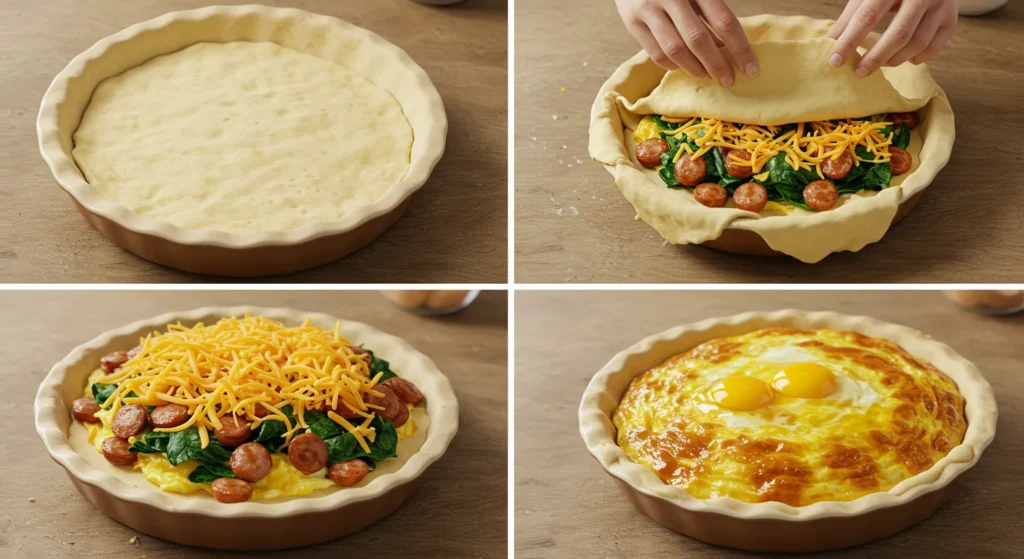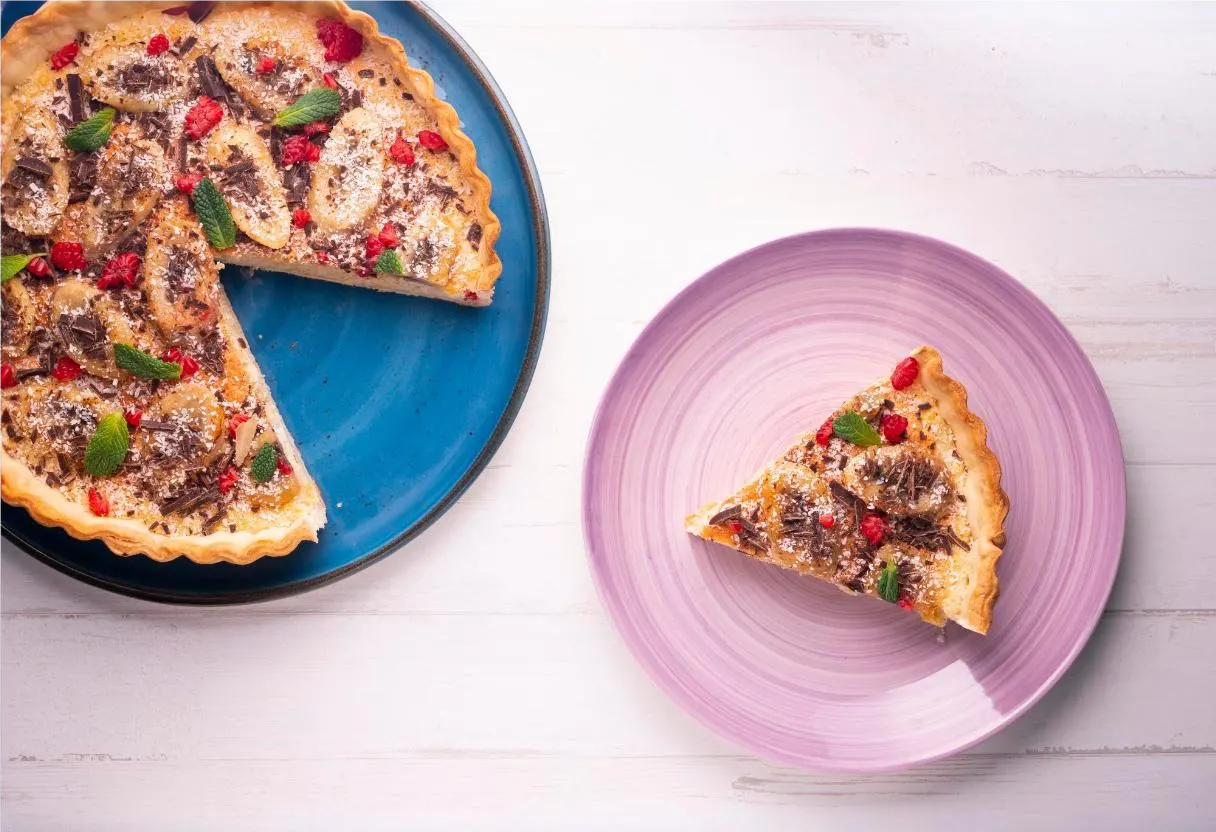This article explores the art of making a breakfast pie, examining its history, components, and recipe variations. Learn how to create a savory morning masterpiece that balances flavor and nutrition, all in one delightful crust.
Introduction
Starting your day with a slice of breakfast pie may sound unconventional; however, this hearty creation has captured the interest of home cooks looking for variety in their morning routine. Instead of the usual scrambled eggs on toast, a breakfast pie allows you to combine layers of flavors, all baked to perfection in a crisp, golden crust. This approach not only makes breakfast more interesting but also yields a dish that is easy to portion, store, and reheat—perfect for hectic mornings or leisurely weekend brunches.
In addition, breakfast pie is highly adaptable. You can customize it with assorted vegetables, turkey sausages, eggs, plant-based options, cheese, or savory seasonings. Therefore, people of all dietary preferences can take pleasure in this satisfying meal. With U.S.-based traditions in mind, this article presents a comprehensive exploration, guiding you through the origins, variations, cooking techniques, and nutritional considerations of breakfast pie. Our goal is to help you master each step, from choosing the perfect crust to expertly serving your flavorful creation. Let’s dive right in!
- Introduction
- A Brief History of Breakfast Pie
- Defining the Components of a Breakfast Pie
- Nutritional Considerations
- Popular Varieties of Breakfast Pie
- Step-by-Step Breakfast Pie Recipe
- Nutritional Information
- Expert Tips for a Perfect Breakfast Pie
- Serving and Pairing Suggestions
- Regional Spins on Breakfast Pie
- FAQ (Detailed)
- Conclusion (Key Takeaways)
A Brief History of Breakfast Pie
Early Savory Pies in American Cuisine
In many cultures, pies have a long-standing tradition. Colonists from Europe brought savory pie-making skills that evolved over time to include local ingredients. Eventually, these pies morphed into meals suited for any time of day, inspiring the concept of a breakfast pie. While classic pies were often loaded with meats and thick gravies, early American cooks began to experiment, incorporating eggs and vegetables to create a dish more aligned with morning tastes.
Moreover, these savory morning pies provided an efficient way to use leftover roasted vegetables and proteins, minimizing food waste. Combined with minimal preparation in the morning, such dishes became especially appealing to busy families. Consequently, breakfast pies have remained a comforting and creative choice for home cooks for generations.
Modern Adaptations and Popularity
Fast-forward to modern times, and breakfast pie has achieved a cult following. Restaurants and diners across the United States regularly feature versions of quiche-like offerings on their breakfast menus. Home cooks embrace them for brunch gatherings or weekday meal prep. In many U.S. households, the phrase “breakfast pie” goes beyond eggs and crust and refers to a broad category of morning bakes, ranging from plant-based pies to sweet interpretations made with creamy fillings and fruit.
Furthermore, the rise of online recipe communities has led to endless variations and creative spins. Consequently, more individuals incorporate this dish into their morning repertoire, enticed by the simplicity of a single-pan meal that can serve multiple diners.
Defining the Components of a Breakfast Pie
Crust Selection
A crucial element of breakfast pie is the crust. Traditionally, a flaky pastry crust serves as the foundation. However, if you seek a different texture and taste, consider these alternatives:
- Phyllo Dough: Layers of paper-thin dough that bake into a light, crispy crust.
- Puff Pastry: Offers a rich, buttery finish and delightful crunch.
- Biscuit Dough: Delivers a fluffy and comforting Southern-style twist.
- Hash Brown Crust: Replaces traditional dough with grated potatoes, appealing to potato enthusiasts.
Choosing your crust is a matter of personal preference. However, always ensure your crust is baked or partially baked if using a wet filling. This step prevents sogginess, therefore improving the overall texture.
Filling Elements
- Eggs
Eggs form the center of many breakfast pies. Although whole eggs are common, you can also mix in egg whites for a lighter option. If you prefer to go plant-based, you can use tofu or chickpea flour for an “eggless” alternative. - Protein Options
- Turkey Sausage or Ground Turkey: A savory choice that’s leaner than some traditional options.
- Chicken Sausage or Diced Chicken: Adds a hearty punch of flavor.
- Plant-Based Sausage: Ideal for vegetarian or vegan diets.
- Vegetables
- Spinach or Kale: Boosts the nutritional value with essential vitamins.
- Onions and Bell Peppers: Adds a sweet, savory note.
- Mushrooms: Contributes hearty texture and earthy flavor.
- Cheese
- Cheddar: A classic choice for a robust taste.
- Mozzarella: Milder flavor, pairs well with various seasonings.
- Goat Cheese: Adds a tangy profile, ideal for gourmet flair.
- Seasonings
Common herbs and spices include parsley, chives, paprika, and chili flakes. You can also add an acidic element like a splash of lemon juice to brighten the flavors.
Nutritional Considerations
Macronutrient Balance
Striking a balance between proteins, carbohydrates, and fats is essential for a well-rounded morning meal. Eggs and turkey sausage supply protein, while the crust contributes carbohydrates. Cheese often delivers dietary fat, though you can also add healthy fats with items like avocado or olive oil-based spreads. Therefore, a breakfast pie can provide sustained energy to carry you through your morning.
Lower-Calorie Swaps
If your dietary goals involve reducing calories:
- Opt for low-fat cheese or modest cheese portions.
- Use egg whites or a higher ratio of egg whites to whole eggs.
- Select vegetables high in fiber and water content, such as zucchini or tomatoes.
- Consider cooking methods that reduce added fats, like sautéing vegetables in non-stick pans or using cooking sprays sparingly.
Nutritional needs vary from person to person. However, with careful selection of ingredients, you can create a breakfast pie that is both flavorful and mindful of calories.
Popular Varieties of Breakfast Pie
Classic Quiche-Style Pie
When many people think of a pie made of eggs, they picture a quiche. Quiche features a custard base (eggs mixed with milk or cream) poured into a pastry crust. Traditional quiche often includes ingredients like spinach, onions, cheddar cheese, and turkey sausage. Its texture remains slightly creamy yet set, and the crust offers a flaky, buttery contrast.
Moreover, quiche can be served warm or at room temperature, making it suitable for brunch gatherings where guests arrive at different times. Because of its versatility, quiche stands out as a go-to dish for many home cooks, and it is perhaps the most recognizable style of breakfast pie in the United States.
Handheld Breakfast Pie
Another interesting take on breakfast pie is the hand pie. Hand pies are portable, individual pastries stuffed with egg mixtures, cheese, and fillings of choice. For example, using store-bought puff pastry, you can create sealed pockets that bake into a golden bundle of morning goodness.
Furthermore, hand pies lend themselves well to meal prep. You can make a batch on the weekend, freeze them, and reheat as needed. Their compact form also means they travel well, therefore they are perfect for busy mornings on the go.
Vegan Morning Pie
In recent years, plant-based diets have gained popularity, leading to creative adaptations for traditional recipes, including breakfast pie. Vegan pies often utilize tofu scrambled with vegetables, nutritional yeast, and spices like turmeric for color. You can also use chickpea flour to create an egg-free “filling” that sets similarly to eggs.
Additionally, vegan crusts can be made from whole-wheat pastry dough or other non-dairy substitutes. This approach ensures that anyone seeking a plant-based breakfast can enjoy a delicious savory pie without compromising taste.
Sweet Breakfast Pie
While savory pies dominate the breakfast scene, sweet breakfast pies are an exciting alternative. Many people bake fruit pies or custard-based pies and serve them as a special breakfast treat. Fresh berries, apples, or peaches can form a sumptuous filling, combined with a bit of cinnamon or nutmeg. Although these sweet pies might resemble a dessert more than a main course, they can still feature health-conscious adaptations, such as cutting sugar levels or using whole-grain crusts.
Step-by-Step Breakfast Pie Recipe
Below is a versatile breakfast pie recipe adaptable for various diets. Feel free to substitute ingredients to match your preferences.
Ingredients
- Crust: 1 ready-made pie crust (9-inch), partially baked
- Egg Mixture:
- 4 eggs
- 1 cup of milk (or half milk, half cream)
- ½ teaspoon salt
- ¼ teaspoon black pepper
- Filling:
- 1 cup diced turkey sausage or 1 cup of a plant-based sausage alternative
- ½ cup chopped onions
- ½ cup chopped bell peppers
- 1 cup chopped spinach
- 1 cup shredded cheese (cheddar or mozzarella)
- Seasonings:
- ½ teaspoon paprika
- ½ teaspoon dried parsley
- Pinch of chili flakes (optional)
Cooking Instructions

- Preheat Your Oven
Preheat the oven to 375°F (190°C). This temperature helps ensure the filling cooks evenly while browning the crust nicely. - Prepare the Crust
- If using a store-bought crust, follow the instructions for partial baking.
- If making from scratch, roll out your pastry dough, fit it into a 9-inch pie dish, and lightly prick the bottom with a fork. Then, line with parchment paper and use pie weights (or dried beans) to keep the crust flat while partially baking for about 10 minutes.
- Cook the Filling
- In a lightly greased skillet, sauté the turkey sausage (or plant-based sausage) until browned. Drain any excess liquid.
- Add onions and bell peppers to the skillet. Sauté until the onions are translucent and the peppers are slightly soft. Stir in chopped spinach until wilted. Set this mixture aside to cool slightly.
- Assemble the Egg Mixture
- In a medium bowl, whisk together the eggs, milk, salt, pepper, paprika, dried parsley, and chili flakes if desired.
- Make sure everything is well combined, as an even mixture yields a smoother final pie.
- Layer Your Pie
- Scatter the cooked sausage and vegetables evenly onto the partially baked pie crust.
- Sprinkle shredded cheese on top of the filling.
- Gently pour the egg mixture over the sausage, vegetables, and cheese. The mixture should cover the fillings adequately but leave at least ¼ inch of space from the top of the crust.
- Bake
- Transfer the assembled pie to the preheated oven.
- Bake for approximately 30–35 minutes, or until the center is set and the top is lightly browned.
- To test if it’s done, insert a knife into the center. If it comes out clean, your breakfast pie is ready.
- Let It Rest
- Carefully remove the pie from the oven and place it on a cooling rack for at least 10 minutes. Resting allows the filling to set fully.
- Slice and serve warm.
Nutritional Information
Below is approximate nutritional information for this breakfast pie (per 100g). Exact values will vary based on specific brands and portions:
| Nutrient | Amount (per 100g) |
|---|---|
| Calories | 220 kcal |
| Protein | 10 g |
| Carbohydrates | 16 g |
| Fats | 12 g |
| Fiber | 2 g |
| Sodium | 350 mg |
| Calcium | 120 mg |
| Iron | 1.5 mg |
This breakdown reflects a balance of macronutrients. If you need to adjust the nutritional profile, consider swapping out certain ingredients as suggested in earlier sections.
Expert Tips for a Perfect Breakfast Pie
Avoiding a Soggy Crust
One of the most common pitfalls for novices is ending up with a runny crust. To overcome this, partially pre-bake (blind-bake) the crust. Cover it with parchment paper or foil and use pie weights so the crust does not puff up. Once it is lightly golden, remove it from the oven and let it cool slightly before adding the fillings. Therefore, extra moisture is less likely to seep into the dough.
Mixing and Matching Flavors
To craft a memorable breakfast pie, start by balancing sweet, savory, and tangy elements. For example, if you are using a slightly sweet vegetable like caramelized onions, counterbalance with a tangy cheese or add a hint of acid like a splash of lemon juice. Likewise, consider layering in fresh herbs or a mild spice. Consequently, every bite remains rich and intriguing.
Storage and Reheating
If you have leftovers, store them in an airtight container in the refrigerator for up to four days. When reheating, an oven at 350°F (175°C) preserves the crust’s crispness and reheats the filling evenly. Avoid microwaving for extended periods, as it can render the crust soggy.
Serving and Pairing Suggestions

Beverages
- Coffee or Tea: A robust cup of coffee or a soothing herbal tea pairs well with a savory breakfast pie.
- Fresh Juice or Smoothies: If you want something light and refreshing, an orange or green juice complements the richness of the pie.
Complementary Sides
- Fruit Salad: A colorful bowl of sliced fruit brightens the meal.
- Green Salad: A lightly dressed salad of mixed greens can balance out a hearty slice.
- Roasted Vegetables: If you want even more produce, consider roasted cherry tomatoes, asparagus, or sweet potatoes.
Presentation
Presentation can elevate a simple dish into a restaurant-quality experience. Garnish with chopped fresh chives or parsley. Arrange colorful produce on the plate for added visual appeal.
Regional Spins on Breakfast Pie
Southern Influence
Southern-style breakfast pies may use biscuit dough as the crust, along with creamy gravy-inspired fillings. This type of breakfast dish is reminiscent of down-home cooking, which is why it often appears in casual family-style gatherings.
Southwestern Twist
For those who crave bold flavors, a southwestern breakfast pie might incorporate chili powder, bell peppers, and turkey chorizo (or a plant-based spicy sausage). You could top it off with shredded pepper jack cheese for an extra kick. Therefore, if you enjoy Tex-Mex cuisine, this variation is an excellent choice.
Northeastern Flair
In the northeastern United States, certain areas are known for incorporating seafood in unexpected ways. Although seafood in a breakfast pie is less common, some might experiment with crab or smoked fish for special occasions. Serve it with a fresh green salad or roasted vegetables for a distinctively coastal feel.
FAQ (Detailed)
Below are some commonly asked questions about breakfast pie, along with thorough answers to guide you further.
What is a pie made of eggs called?
A pie made of eggs is generally called a quiche, which features eggs and other fillings in a pastry crust. Quiche can be served for breakfast, brunch, or even lunch and dinner.
What is Dolly Parton pie?
Dolly Parton pie, often associated with the iconic country singer’s southern roots, typically refers to a sweet pie. It may feature ingredients like coconut, buttermilk, or even fruit. While Dolly Parton pie is not necessarily a breakfast pie, some people enjoy a sweet slice in the morning with coffee. However, it is generally considered a dessert pie.
Is a Yankee someone who eats pie for breakfast?
The term “Yankee” historically refers to a person from the northeastern United States. The saying about Yankees eating pie for breakfast is anecdotal, reflecting old traditions of New England families enjoying leftover fruit pies for breakfast. Although not everyone follows this practice, the phrase underlines the region’s long-standing affinity for pie at various meals.
Can you have pies for breakfast?
Yes, you can absolutely enjoy pies for breakfast. Whether it’s a savory quiche-style pie or even a leftover fruit pie, enjoying a slice in the morning can be a fun way to switch up your routine. However, if you want a more balanced breakfast, opt for savory options filled with eggs, vegetables, and moderate amounts of cheese.
Conclusion (Key Takeaways)
In summary, breakfast pie offers a convenient and flavorful way to start your day. From quiche-like custards and vegan tofu scrambles to sweet fruit-filled pastries, there is a version to suit every palate. Moreover, the crust serves as the perfect vessel, cradling a range of nutritious fillings. Always remember to partially bake your crust if your filling is especially moist, and be strategic about layering flavors and textures for a truly memorable slice.
Because breakfast pie is easy to store and reheat, it also meets the demands of fast-paced mornings. Ultimately, consider exploring different crusts, proteins, vegetables, and seasonings to craft a breakfast pie that reflects your unique tastes. We hope this comprehensive guide inspires you to experiment, impress your family or friends, and perhaps invent the next must-try breakfast sensation.
For those looking to explore more breakfast ideas, check out our amazing list of resources. You may enjoy:
- Egg White Frittata Recipe (Embed here to guide readers to another high-protein breakfast idea.)
- Delicious Breakfast Pizza Rolls (Embed here for a fun, portable twist on morning meals.)
These related posts introduce fresh strategies and flavors for your morning meals, pairing nicely with the concept of breakfast pie.

